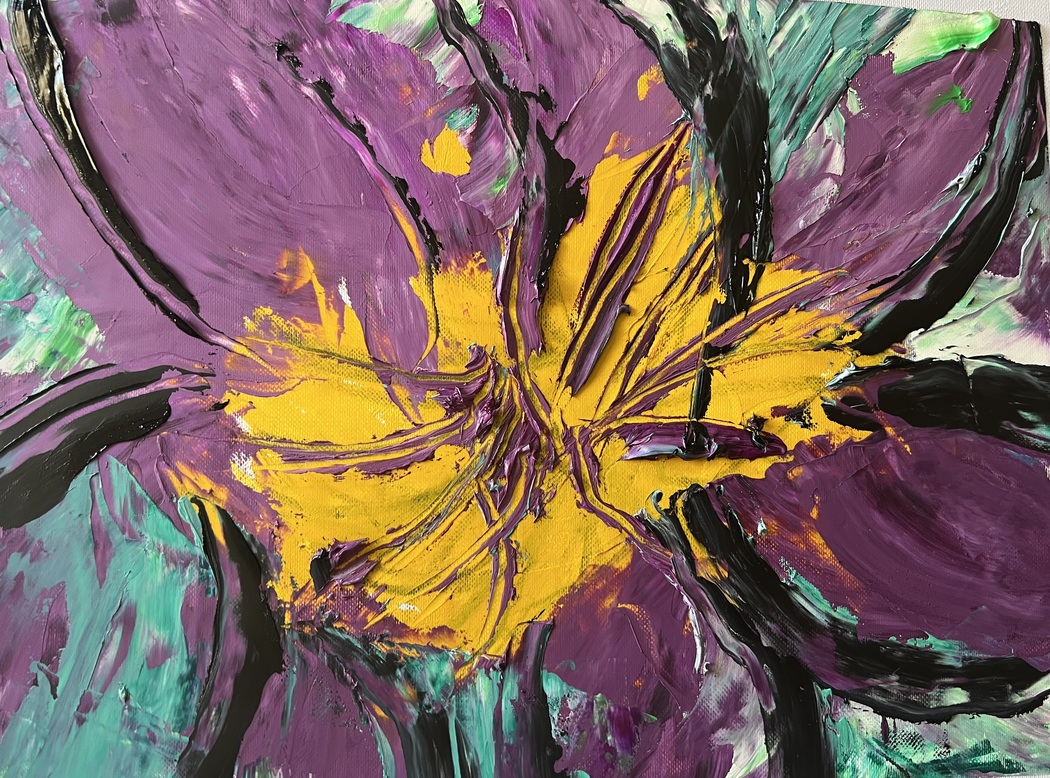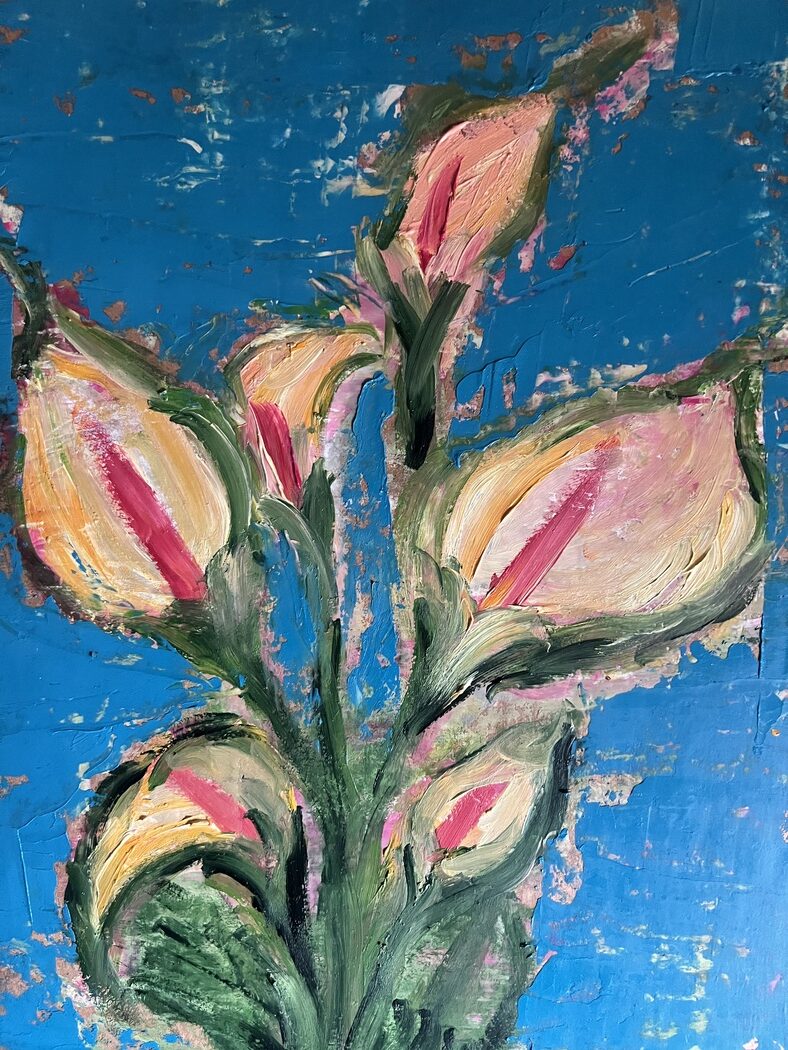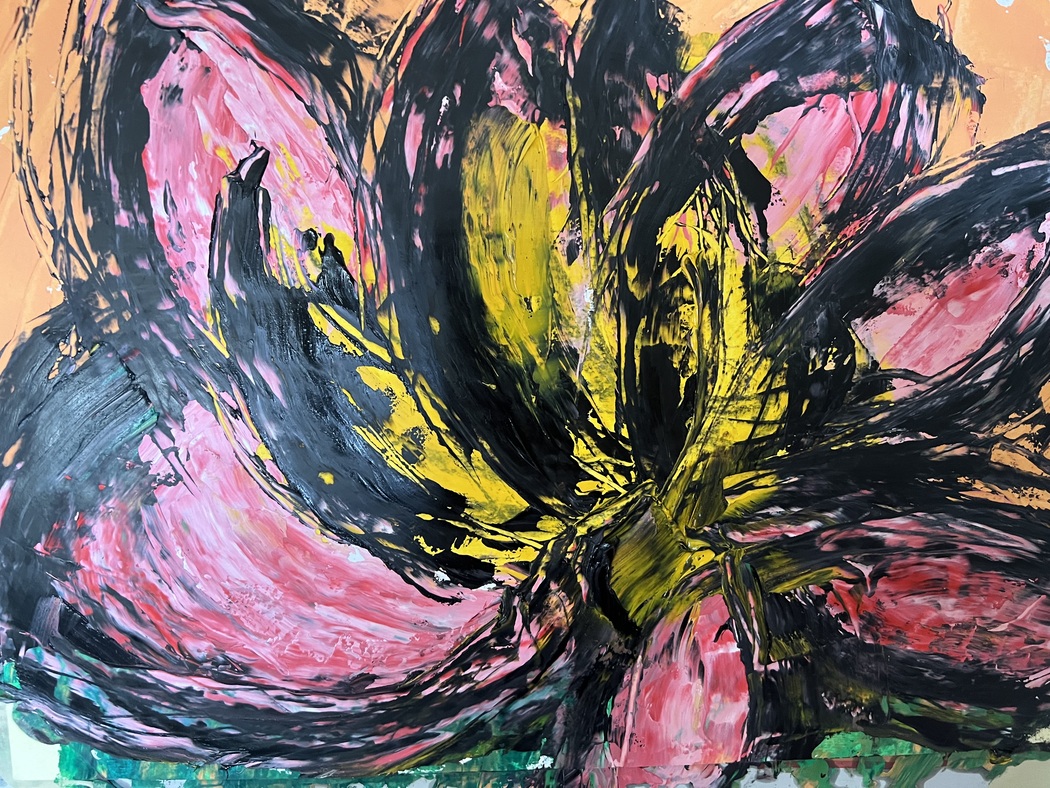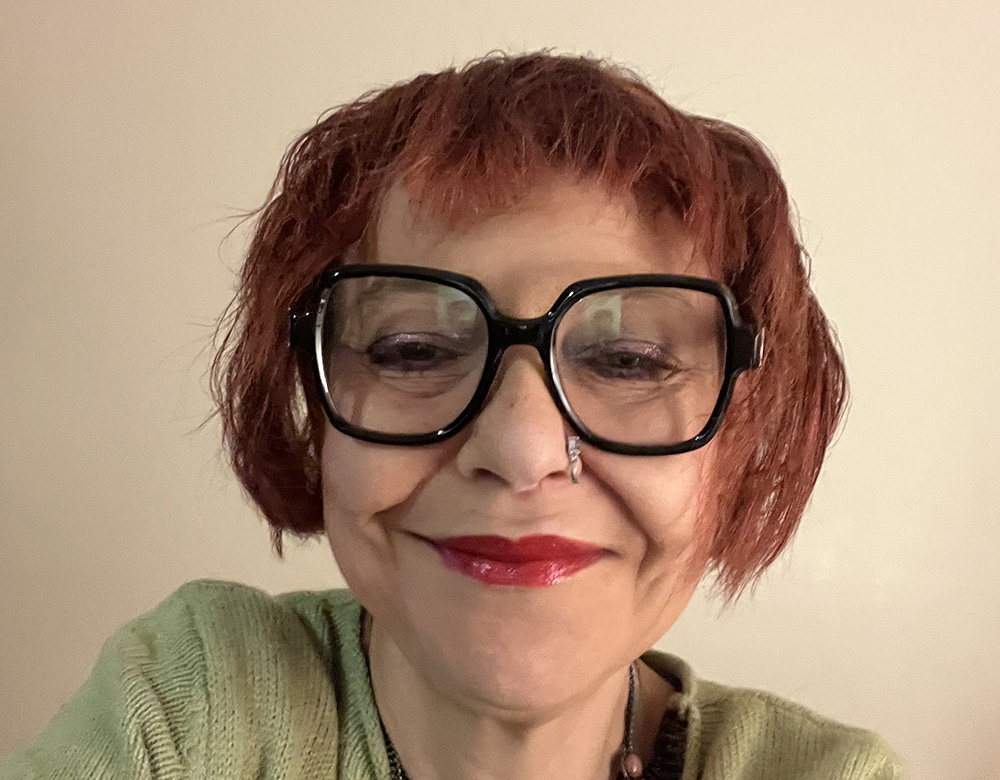Alison Hirst Lebègue
Year of birth: In June 1972 so soon 53 years-old
Where do you live: I live in Rambouillet, a town South West of Paris in the countryside, in a very quiet residence, in which I feel very inspired, although my studio is my flat, so very little space available so I need to be well organised.
Your education: 6 years post French Baccalaureat with a BA (First class) in Visual Culture in 1997.
Describe your art in three words: colours, abstraction, texture
Your discipline: Painting using all types of media: pastel, charcoal, watercolours, inks, linoprints, oil and acrylic paints.
Website
You mentioned that art has always been a part of your life. How did the influence of your grandfather and great-grandfather shape your approach to art?
They were both major artists painting from clothes design to architectural pieces for private gardens and palaces, like gardens’ gazebos. My great-grandfather, Henri Lusseau, also designed gardens and parts of some palaces in Lisbon, Portugal as both an engineer and a landscape architect. My father who is very proud of such art works has always hung some of their best works in our house, so I’ve been surrounded by them since I was born. And following a recent experiment of using stencils, my father gave me my grandfather’s brushes since he also designed stencils. I feel very blessed to have them and to be using them now.
They mainly used watercolours which is probably why I so much like this media too. Their use of watercolours was very soft, as opposed to mine which is more colourful, but they remain a great inspiration. They also taught me to look closely and study others’ works of art, and that right from an early age. Hence my decision to study two hears in History of Art in 1992.
Finally, their love for art was not just about creating—it was about observing the world with curiosity and finding beauty in everyday moments. This perspective stays with me to this day, influencing the way I approach each piece, whether through colour, texture, or composition. Their legacy instilled in me a deep appreciation for both tradition and innovation, allowing me to develop my own artistic voice while staying connected to the past.
 AERH Arts | Flower #01 | 2025
AERH Arts | Flower #01 | 2025
You have a rich educational background in both fine arts and visual culture. How did these experiences inform your art practice and understanding of visual works?
Indeed, I’ve been in fine art since an early age see my Picasso at primary school!
I took private lessons during high school and chose a fine art baccalaureate. Then I entered the first year of the famous ENSAG Graphic Art School in Paris where I learnt with a profonde commitment all sorts of techniques from which my favourite ones were painting from plaster busts but also nudes, especially when in movement. I then turned to theory which is essential for me in order to progress in my art practice, by research and analyses of other major painters. So, I did a two-year university course in History of Art of which I especially remember the subject of Indian Art History which later on inspired me to travel to India and Nepal following the route of Buddha and discovering all the art and craftwork around his religious journey.
Finally, I ended my education with a Bachelor of Art in Visual Culture in Falmouth, UK… being bilingual from birth (my mother is English) made it easy to study this course and I graduated with a first a first-class degree and as a the major of my promotion. There I studied a lot of philosophy, reading Foucault but also Bakhtin and Levi-Strauss and finally a group of feminist scholars, including Cixous, Irigaray and Kristeva. My major dissertation was titled: “THE DIALOGICAL DISCOURSES OF THE ABJECT: THE USES AND MEANS OF THE ABJECT IN WESTERN FEMININE FINE ART PRACTICES”. I loved exploring these women’s art works and trying to understand their practice, as well as my place as a woman in a patriarchal society. In this dissertation I insisted on the use of the body in art… which later influenced me for my nudes but also for my women’s portraits. Artists I studied included: Cindy Sherman, Helen Chadwick, Laura Godfrey-Isaacs but also Gilbert and George.
This education has widened my own practice and how to understand major artists’ works. It has also motivated me to travel and visit museums across the world. I recently visited the permanent collection of Beaubourg centre in Paris (that was easy I live near Paris!) and was overwhelmed and inspired by the artists who worked as from 1905 till the 1990’s. In the past, I have been to Barcelona, Venice, twice for the Biennale, Madrid, New York, Prague, Berlin, Amsterdam but also in a different style to Giverny’s gardens. I also travel to London at least once a year and always pay a visit to the Tate Modern… the list of museums is rather long!
After a break from oil painting, you’ve made a remarkable return in 2024. What inspired you to go back to oil painting, and how has your approach evolved?
It was indeed a big challenge and that’s why it took so long for me to get back in this art practice! It started in February 2024 after having been offered oil paints at Christmas, with at the time a WhatsApp group focusing on an art challenge with my mother. Part of this group, were a jury of four women friends launching the challenges and then voting for the best artworks. One of these challenges was to paint a stary night sky above a mountain. I suddenly knew I had to try oil for this challenge, which came to this result:
This challenge was then followed by a more floral one, and that was it I was back in oil painting after a stop in this practice of nearly 15 years! I had just finished a long series of landscapes using pastels and I was in the need of more details, hence being very happy in taking part in this floral challenge that after saw me painting a series of flowers and flowery fields. I then wanted texture which I mainly get using a palette knife in my practice. I was also inspired by Monet’s House of Parliament but also Van Gogh and Miro, and as I said developing the use of a palette knife, which is a very difficult technique that is a big challenge for me but I love it!
I’m highly interested in adding texture to my paintings that’s why I’m so keen on using a palette knife and oil paint instead of watercolours or acrylic – which I also use a lot though. I go through a lot of paint. I guess the floral theme is partly inspired by my visit many years ago to Monet’s gardens in Giverny. Contrary to my major dissertation for my BA, I’m not inspired by contemporary art but more by the impressionists, cubism and figurative art dating of the early 20th century, before and after the two World Wars. The palette knife helps creating this thick texture to the artwork, getting close to sculpture which I tried back when I was in Paris art school using papier mâché or plaster on fish net. But coming back to my prolific art using oil again after such a long break is a real challenge and I pick up photos of flowers on the internet to get inspiration for the drawing which is the base of any painting, even if one finishes by creating a distortion of the original drawing like I end up doing when I apply the paint. And besides oil paint has a smell what because of the use of turpentine. I used to love visiting artists’ studios at Paris Ecole des Beaux-Arts on the way to my art school. Smelling spirits and observing. Now I do it on my little workshop at home.
Music is also very important for the movements required to adding the paint to the canvas. It all depends on my mood of the day. I can paint listening to Vivaldi and the next minute to heavy metal music! It changes it all. I mean the outcome of the painting is so different. The only links are the use of colours and adding texture. But my body language will definitely be different. The only difficulty with oil is that you have to be patient to let it dry not like acrylic. So, it may take several days to finish an oil painting hence making several ones at the same time. I now have a record of about 50 oil paintings done over the past year.
 AERH Arts | Lylies | 2024
AERH Arts | Lylies | 2024
You’ve worked with a variety of mediums, including watercolours, pastels, chalk, oil painting, and linocuts. How do you choose which medium to use for a specific theme?
I choose my medium based on the mood, texture sought, and depth I want to convey in each piece. Watercolours allow me to create fluid, dreamlike atmospheres, perfect for ethereal or emotional themes. When I want a richer, velvety softness, I turn to pastels, which bring warmth and the important results in blending the colours with my fingers. Oil painting gives me the ability to build layers and textures as I have already explained, making it ideal for pieces that require depth and bold expression, especially with the use of the palette knife. Linocuts, with their strong contrasts and graphic quality, work well when I want to emphasize form and structure in a more dynamic, expressive way. Each medium has its own unique voice, and I love exploring how different techniques can enhance the story I want to tell.
I find that each theme or concept naturally calls for a specific medium, and I often feel the need to switch between them to keep my creative process prolific. Some ideas demand the fluidity and unpredictability of watercolours, while others need the rich, tactile quality of pastels or the depth of oil paint. Changing mediums allows me to explore different textures, contrasts, and moods—keeping my work fresh and allowing me to push boundaries. Each medium offers a new way to interpret an idea, and by shifting between them, I ensure that my work remains exciting, both for me and for the viewer.
In your watercolours work, you create a dreamlike world. Could you tell us more about the emotions or ideas that you hope viewers experience through your work?
In my watercolour work, I strive to create a dreamlike world that evokes a sense of wonder, nostalgia, and tranquillity. My goal is to invite viewers into a space where reality blends with imagination, allowing them to pause and immerse themselves in a moment of peace. Through soft, flowing colours and delicate transitions, I hope to convey emotions of introspection, and a touch of mystery, I indeed tend to call them “Abstract landscapes”, that I highlight using Chinese black ink, which is originally a traditional, rich black ink used in calligraphy. I want each piece to feel like a fleeting memory or a forgotten dream, sparking personal interpretations and emotions unique to each viewer.
I also love working with strong-coloured inks because they add depth, energy, and contrast, allowing each piece to pulse with emotion and movement. These bold pigments help me shape surreal landscapes but also a whole series of vanities, that feel both immersive and evocative. I want viewers to experience a sense of wonder, as if stepping into a vivid dream where colours tell their own story. My goal is to spark emotions that result in exhilaration, inviting each person to find their own meaning in the interplay of light and colour.
 AERH Arts | Flower #02 | 2025
AERH Arts | Flower #02 | 2025
Your landscapes and portraits often reflect personal themes or cultural influences. Can you talk about a specific landscape or portrait that has a special meaning to you?
The portrait of Frida Kahlo in oil paint is a very important one to me, not only because I love her artwork but also because she was a beautiful woman, with fine traits and a colourful style which suits my use of colours.
It thus holds deep significance for me—not only because I deeply admire her artwork, but also because she embodies strength, resilience, and a unique artistic spirit that resonates with me. Her striking features, intense gaze, and vibrant, symbolic style align perfectly with my own use of bold colours and expressive brushwork. Through this portrait, I sought to convey not just her physical beauty, but also the depth of her emotions and her devotion throughout her life and art. In many ways, painting her felt like a tribute to the creative freedom that I strive for in all my works.
The Japanese prints you’ve created following your trip to Japan must have had a strong impact on you. How did the experience of visiting Japan shape your artwork?
Visiting Japan in 2015 was a profoundly inspiring experience that deeply influenced my artwork. Immersing myself in the country’s rich artistic traditions, from delicate ukiyo-e prints to the harmony of nature in Japanese aesthetics, made me see composition, colours, and detail in a new way. I was particularly drawn to the elegant simplicity and refined linework in traditional woodblock prints. One of the most captivating aspects of my trip was witnessing the beauty of cherry blossoms in full bloom. The delicate, fleeting nature inspired me to explore softness and details in my paintings.
Following this trip, I’ve found myself testing to incorporate more minimalism, delicate patterns, and a sense of tranquillity into my work, striving to capture the essence of what moved me so deeply in Japan. I painted about 21 artworks of details of the beauty of cherry blossoms in full bloom. In my cherry tree paintings, I focus on the contrast between the fragile blossoms and the dark, textured branches by using Chinese black ink and blending it to provide some light, emphasizing the poetic balance between strength and ephemerality. I also experiment with different techniques to reflect the movement of falling petals, using fluid brushstrokes and delicate colour transitions to evoke a sense of time passing.


Leave a Reply